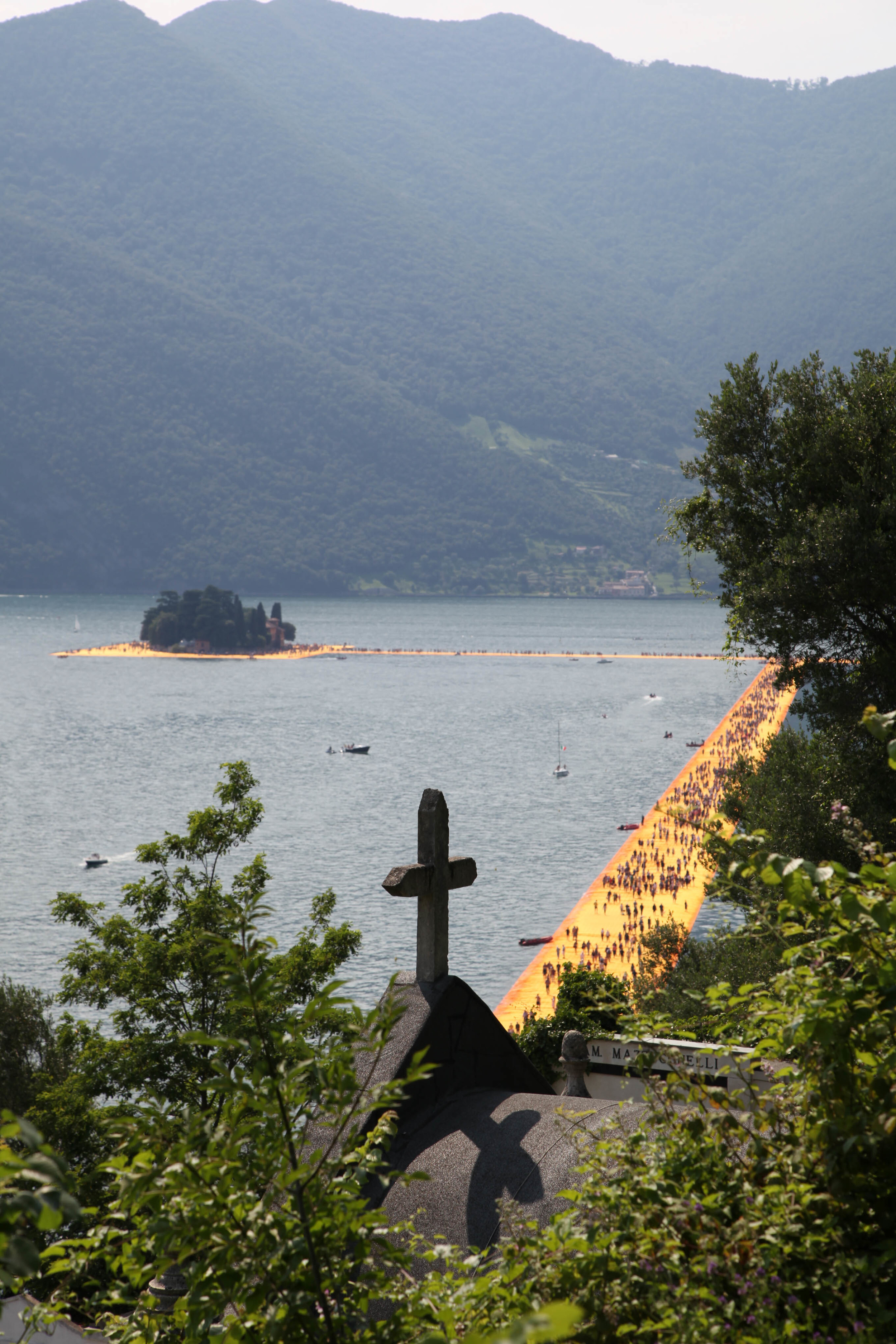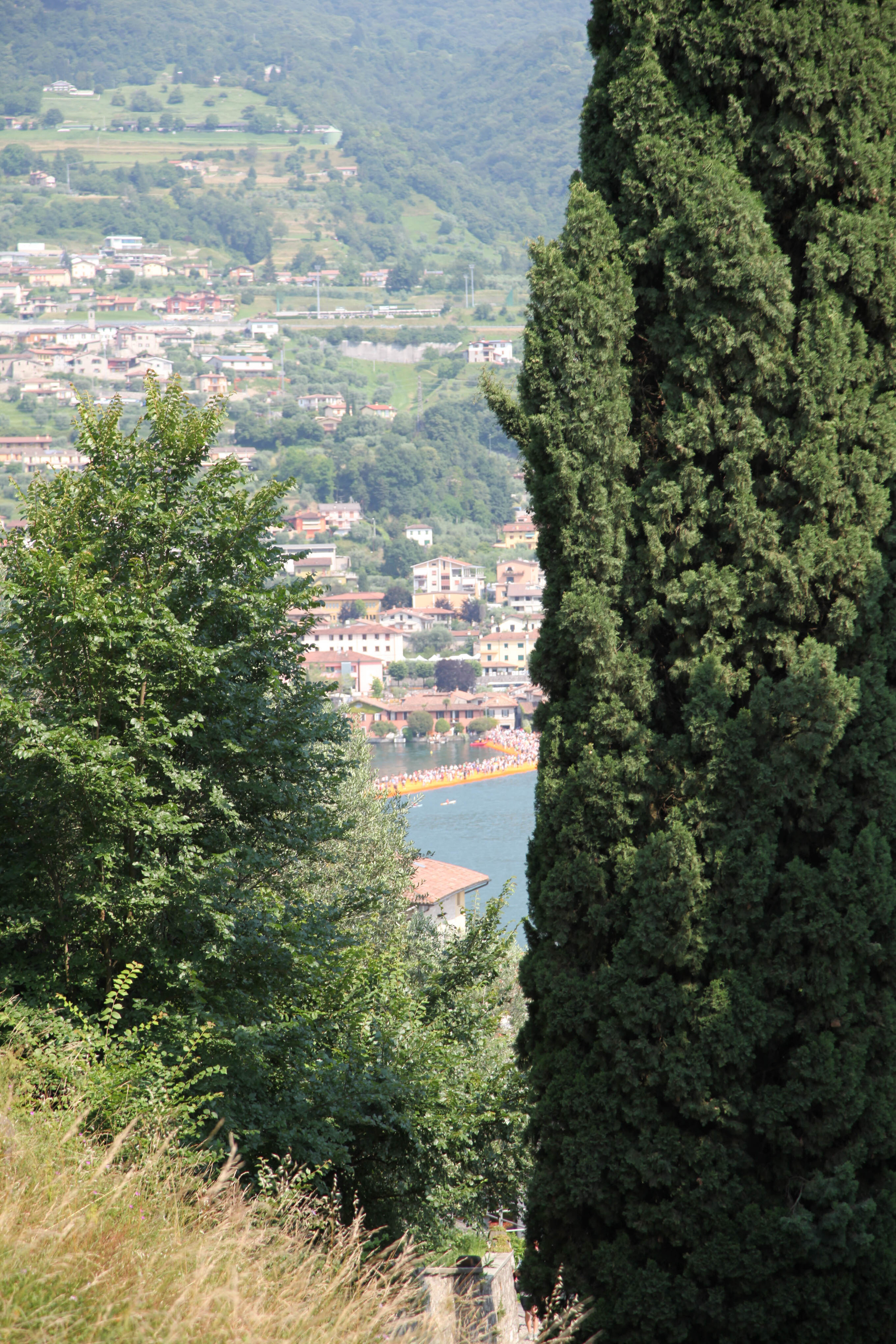The following is a description of Christo's The Floating Piers, a temporary art installation in Lake Iseo, Italy as experienced by N+T Director, Kate Gilbert.
June 21, 2016. 2:31 pm. I have landed on the most incredible surface. I’ve traveled 231 miles by train, 3,995 by plane, a combined 97 miles by car, and now, after a 20-minute boat ride, I am here, stepping onto Mounte Isola Island and the brilliant ribbon of orange surrounding it. I have made it to Christo’s latest work, The Floating Piers, a temporary new experience, dare I say a new ground, which he’s created to last only 16 days.
Stepping onto the terra firma of the island I am quickly engulfed by a slow-moving sea of other explores donning sunglasses, hats, umbrellas, and carrying equal parts water bottles and cigarettes. Without stopping—for a bit of panic arises, I cannot lose my companions—I look down long enough to inspect the fabric being stretched into bunches by the shuffling feet and straining at the edges.
I learn later that over 270,000 people turned up in the first five days. As many as 45,000 people may have been there that day, 15,000 more than anticipated.
As we step out onto the water-borne section of the piers voices rise up around me. Although they’re speaking a language I don’t comprehend, I know instinctively of what they speak. Roughly translated, “Whoa, it’s moving!”
This is to be expected. It’s a pier after all. But unlike other piers where there’s the initial discernment of a change in stability from one to the other, this one keeps moving; it keeps undulating. No one can fully explain just how buoyant and dynamic the floor of The Floating Piers really is. It’s like walking on many tiny piers put together. It’s like, well, walking on water.
My three companions desire to sit down. They are, we all are, after all, rule breakers and do not wish to be swept up in the mass of tourists who seem to be blindly walking. Isn’t this Christo’s idea, to create an experience of walking? We can’t. The change in equilibrium and the hordes of people are all too much.
We sit. We take pictures. We remove our shoes. We observe, trying to take it all in. Streams of people come by, always in clusters. Families. Elders. Dogs. One selfie stick. Mostly locals, many are well on their way to a sunburn. We are almost stepped on.
As I move to position myself far enough from the wet edge yet out of the thoroughfare, I marvel at the bunched fabric. Why aren’t more people tripping?
Barefoot and upright again, we take more pictures. This is when our magical territory displays its hidden property, something I haven’t yet read about in others’ encounters; it’s a conduit for static electricity! Later, upon inspecting the fabrication, I learn the piers are made from 200,000 high-density polyethylene cubes, covered by a layer of insulating batting with a final nylon fabric on top. No wonder the static.
I observe a young boy, maybe seven-years-old, run up to his family and with a sly grimace touch his father and laugh. Shock! My elbow brushes my husband. Shock! I grasp a metal railing at the shore to put my shoes back on. Shock!
The heat has now reached over 90 and the walking for the sake of walking, elbow to elbow with the others, has tired us out. We escape to higher ground for a better understanding of what this tiny island of about 2,000 people must be like when it is not the center of one of the most talked about international art sensations. (For the record, we were there before Michelle Obama visited.)
From our vantage point above a graveyard, we can see both the eastern and western walkways that extend from the island. Tiny filaments of orange connect island to island, and island to shore. They seem to pixelate. Those specks of moving black are people, thousands of people. And that’s when it hits me. The Floating Piers is the great equalizer.
We are all there to walk on new land, to experience a fantasy like walking on the ceiling that we’ve envisioned in our youth or during a dreamy state. With collars of orange glowing under our necks, we walk together. We are not that dissimilar. I am orange, he is orange, they are orange. We are jabbering away in different languages. We are taking in various experiences. (I marvel at the engineering and the lack of regulations. My companion sees the beauty of the orange on blue and the living painting being created.) Yet as different as our takeaways may be, we are all witness to a singular, magnificent vision spawned in the 1970s and finally realized today thanks to the citizens of the Lake Iseo area, new technologies, and the dedication of two artists and their tireless team.
My awe and thanks go out to Christo and his late wife Jeanne-Claude for taking risks; for looking aside when people wondered why such an elaborate project; for moving forward when other cities said no; for being brave in their vision.
Before we board the ferry, Christo’s unmistakable figure, a shock of white hair batted about by the breeze, cruises by us on his barge. To an individual, every one of us claps and hoots with our orange-tinted faces smiling up at him. Bravo, Christo. Bravo.
Image: Wolfgang Volz
All images courtesy of Kate Gilbert except where noted.












